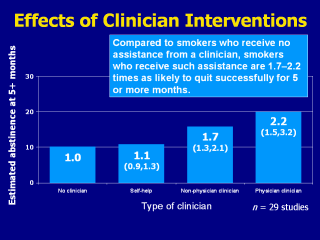 |
Decades of research tell us that clinicians can
have an important impact on their patientsí likelihood of achieving
cessation. A meta-analysis of 29 studies determined that patients who
received a tobacco cessation intervention from a nonphysician clinician or a
physician clinician were 1.7 and 2.2 times as likely to quit (at 5 or more
months postcessation), respectively, compared with patients who did not
receive such an intervention (Fiore et al., 2000). Self-help materials were
only slightly better than no clinician.
Fiore et al. Treating Tobacco Use and Dependence. Clinical Practice
Guideline. USDHHS, PHS, 2000. |
